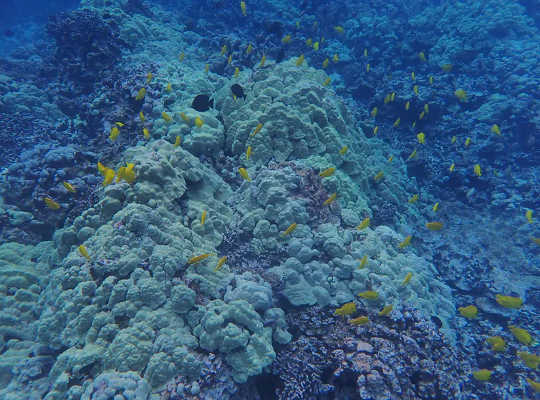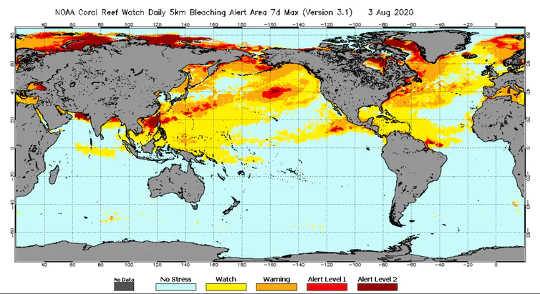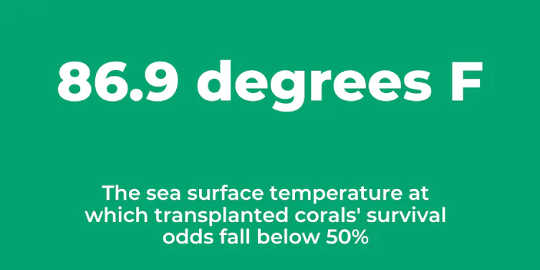
Climate-driven ocean warming threatens healthy coral reefs, like this one in Hawaii. Shawna Foo, CC BY-ND
Anyone who’s tending a garden right now knows what extreme heat can do to plants. Heat is also a concern for an important form of underwater gardening: growing corals and “outplanting,” or transplanting them to restore damaged reefs.
The goal of outplanting is to aid coral reefs’ natural recovery process by growing new corals and moving them to the damaged areas. It’s the same idea as replanting forests that have been heavily logged, or depleted farm fields that once were prairie grasslands.
I have studied how global stressors such as ocean warming and acidification affect marine invertebrates for more than a decade. In a recently published study, I worked with Gregory Asner to analyze the impacts of temperature on coral reef restoration projects. Our results showed that climate change has raised sea surface temperatures close to a point that will make it very hard for outplanted corals to survive.
Coral gardening
Coral reefs support over 25% of marine life by providing food, shelter and a place for fish and other organisms to reproduce and raise young. Today, ocean warming driven by climate change is stressing reefs worldwide.
Rising ocean temperatures cause bleaching events – episodes in which corals expel the algae that live inside them and provide the corals with most of their food, as well as their vibrant colors. When corals lose their algae, they become less resistant to stressors such as disease and eventually may die.
Hundreds of organizations worldwide are working to restore damaged coral reefs by growing thousands of small coral fragments in nurseries, which may be onshore in laboratories or in the ocean near degraded reefs. Then scuba divers physically plant them at restoration sites.
{vembed Y=1N3HNMRd56w}
Outplanting is the process of transplanting nursery-grown corals onto reefs.
Outplanting coral is expensive: According to one recent study, the median cost is about US$160,000 per acre, or $400,000 per hectare. It also is time-consuming, with scuba divers placing each outplanted coral by hand. So it’s important to maximize coral survival by choosing the best locations.
We used data from the National Oceanic and Atmosphere Administration’s Coral Reef Watch program, which collects daily satellite-derived measurements of sea surface temperature. We paired this information with survival rates from hundreds of coral outplanting projects worldwide.
We found that coral survival was likely to drop below 50% if the maximum temperature experienced at the restoration site exceeded 86.9 degrees Fahrenheit (30.5 degrees Celsius). This temperature threshold mirrors the tolerance of natural coral reefs.
Globally, coral reefs experience an annual maximum temperature today of 84.9?F (29.4?C). This means they already are living close to their upper thermal limit.
When reefs experience temperatures only a few degrees above long-term averages for a few weeks, the stress can cause coral bleaching and mortality. Increases of just a few degrees above normal caused three mass bleaching events since 2016 that have devastated Australia’s Great Barrier Reef.
 Sea surface temperatures on Aug. 3, 2020, measured from satellites. Warning = possible bleaching; Alert Level 1 = significant bleaching likely; Alert Level 2 = severe bleaching and significant mortality likely. NOAA Coral Reef Watch
Sea surface temperatures on Aug. 3, 2020, measured from satellites. Warning = possible bleaching; Alert Level 1 = significant bleaching likely; Alert Level 2 = severe bleaching and significant mortality likely. NOAA Coral Reef Watch
Warmer oceans
Climate scientists project that the oceans will warm up to 3?C by the year 2100. Scientists are working to create coral outplants that can better survive increases in temperature, which could help to increase restoration success in the future.
When coral restoration experts choose where to outplant, they typically consider what’s on the seafloor, algae that could smother coral, predators that eat coral and the presence of fish. Our study shows that using temperature data and other information collected remotely from airplanes and satellites could help to optimize this process. Remote sensing, which scientists have used to study coral reefs for almost 40 years, can provide information on much larger scales than water surveys.
Coral reefs face an uncertain future and may not recover naturally from human-caused climate change. Conserving them will require reducing greenhouse gas emissions, protecting key habitats and actively restoring reefs. I hope that our research on temperature will help increase coral outplant survival and restoration success.
About the Author
Shawna Foo, Postdoctoral Research Scholar, Arizona State University
This article is republished from The Conversation under a Creative Commons license. Read the original article.
Related Books
Life After Carbon: The Next Global Transformation of Cities
by Peter Plastrik , John Cleveland The future of our cities is not what it used to be. The modern-city model that took hold globally in the twentieth century has outlived its usefulness. It cannot solve the problems it helped to create—especially global warming. Fortunately, a new model for urban development is emerging in cities to aggressively tackle the realities of climate change. It transforms the way cities design and use physical space, generate economic wealth, consume and dispose of resources, exploit and sustain the natural ecosystems, and prepare for the future. Available On Amazon
The future of our cities is not what it used to be. The modern-city model that took hold globally in the twentieth century has outlived its usefulness. It cannot solve the problems it helped to create—especially global warming. Fortunately, a new model for urban development is emerging in cities to aggressively tackle the realities of climate change. It transforms the way cities design and use physical space, generate economic wealth, consume and dispose of resources, exploit and sustain the natural ecosystems, and prepare for the future. Available On Amazon
The Sixth Extinction: An Unnatural History
by Elizabeth Kolbert Over the last half-billion years, there have been Five mass extinctions, when the diversity of life on earth suddenly and dramatically contracted. Scientists around the world are currently monitoring the sixth extinction, predicted to be the most devastating extinction event since the asteroid impact that wiped out the dinosaurs. This time around, the cataclysm is us. In prose that is at once frank, entertaining, and deeply informed, New Yorker writer Elizabeth Kolbert tells us why and how human beings have altered life on the planet in a way no species has before. Interweaving research in half a dozen disciplines, descriptions of the fascinating species that have already been lost, and the history of extinction as a concept, Kolbert provides a moving and comprehensive account of the disappearances occurring before our very eyes. She shows that the sixth extinction is likely to be mankind's most lasting legacy, compelling us to rethink the fundamental question of what it means to be human. Available On Amazon
Over the last half-billion years, there have been Five mass extinctions, when the diversity of life on earth suddenly and dramatically contracted. Scientists around the world are currently monitoring the sixth extinction, predicted to be the most devastating extinction event since the asteroid impact that wiped out the dinosaurs. This time around, the cataclysm is us. In prose that is at once frank, entertaining, and deeply informed, New Yorker writer Elizabeth Kolbert tells us why and how human beings have altered life on the planet in a way no species has before. Interweaving research in half a dozen disciplines, descriptions of the fascinating species that have already been lost, and the history of extinction as a concept, Kolbert provides a moving and comprehensive account of the disappearances occurring before our very eyes. She shows that the sixth extinction is likely to be mankind's most lasting legacy, compelling us to rethink the fundamental question of what it means to be human. Available On Amazon
Climate Wars: The Fight for Survival as the World Overheats
by Gwynne Dyer Waves of climate refugees. Dozens of failed states. All-out war. From one of the world’s great geopolitical analysts comes a terrifying glimpse of the strategic realities of the near future, when climate change drives the world’s powers towards the cut-throat politics of survival. Prescient and unflinching, Climate Wars will be one of the most important books of the coming years. Read it and find out what we’re heading for. Available On Amazon
Waves of climate refugees. Dozens of failed states. All-out war. From one of the world’s great geopolitical analysts comes a terrifying glimpse of the strategic realities of the near future, when climate change drives the world’s powers towards the cut-throat politics of survival. Prescient and unflinching, Climate Wars will be one of the most important books of the coming years. Read it and find out what we’re heading for. Available On Amazon
From The Publisher:
Purchases on Amazon go to defray the cost of bringing you InnerSelf.comelf.com, MightyNatural.com, and ClimateImpactNews.com at no cost and without advertisers that track your browsing habits. Even if you click on a link but don't buy these selected products, anything else you buy in that same visit on Amazon pays us a small commission. There is no additional cost to you, so please contribute to the effort. You can also use this link to use to Amazon at any time so you can help support our efforts.

























